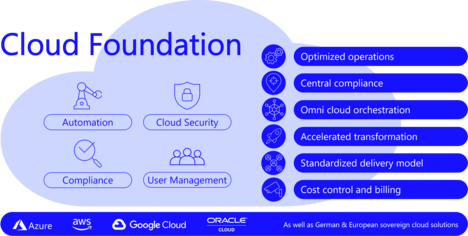
- Blog, Cloud
- Published on: 26.08.2025
- 9:06 mins
Avoiding Cloud Chaos: Why You Can’t Scale Without a Stable Cloud Foundation
Cloud technologies have evolved far beyond IT – they’re now critical growth drivers and innovation enablers for businesses. But the path to the cloud is often more complex than many organizations initially assume. Deploying modern cloud environments isn’t just a technical task but rather a company-wide infrastructure project. It requires clear structures, well-thought-out governance, and a deep understanding of security, scalability, and compliance.
At the same time, pressure from external and internal forces is increasing: regulatory requirements are becoming stricter, cyber threats are on the rise, and the market expects ever faster innovation cycles. IT and business departments are faced with the challenge of reliably providing applications, processing data securely, and simultaneously unlocking new business areas with agility.
The key to success is a stable, standardized, and future-proof technical foundation – in short, a cloud foundation that's considered from the very beginning. It's not an optional add-on but the core success factor for any cloud strategy. Only with a solid foundation can new cloud environments be set up and developed in a controlled, automated, and compliant manner – whether for greenfield projects or complex migrations.
In this article, we explain what matters when designing and implementing a scalable cloud foundation, which success factors are crucial – and how MHP supports you in building a future-proof cloud landscape.
What is a Cloud Foundation?
A cloud foundation is the technical and organizational basis on which you operate your cloud infrastructure. It defines key principles, processes, and architectural requirements for building and using cloud environments. A scalable cloud foundation goes even further and ensures that this basis continues to function reliably even as usage grows, requirements increase, and multiple teams are involved. Reusable architectural building blocks, automation, and integrated security and governance mechanisms are essential elements.
5 Common Mistakes That Cause Cloud Projects to Fail – And How to Avoid Them
Cloud projects are considered accelerators for innovation, scaling, and efficiency. However, many companies experience the opposite: delays, security gaps, and chaos during implementation. The cause rarely lies in the cloud itself, but rather in a lack of preparation. Without a well-thought-out cloud foundation, there is no stable basis for growth, security, and control.
Reason #1: Security is considered too late – instead of being built in from the start
In many projects, security only becomes a focus late in the process. Protective mechanisms are added retrospectively instead of being planned systematically. The result: insufficient protection, higher risks, and insecure systems. Modern cloud architecture must integrate security from the start – based on the “secure by design” principle. This is the only way to sustainably protect applications, data, and resources.
Reason #2: Compliance remains manual – and therefore prone to errors
Today, it involves far more than just meeting legal requirements. Companies must also document internal policies, industry-specific standards, and audit evidence. Without automated controls, the effort involved increases – and with it the risk of violating regulations. A well-designed cloud foundation provides a remedy: it enables automated audit mechanisms, centralized transparency, and reliable compliance.
Reason #3: Unclear responsibilities hinder control and auditability
Who is responsible for what? In many organizations, this question remains unanswered. The result: lack of transparency, insufficient control, and complicated audits. Robust cloud governance defines clear roles and processes – making your environment auditable and manageable in the long term.
Reason #4: Uncontrolled growth instead of standards—time-to-market suffers
Without a consistent architecture, setups become fragmented: different providers, tools, and deployment models lead to inefficiencies and delay new releases. The consequence: competitive advantages are lost. A standardized cloud landscape, on the other hand, accelerates the rollout of new services and improves market readiness.
Reason #5: Technical silos slow down scaling and efficiency
When teams work with different tools, platforms, and methods, isolated system landscapes emerge. This not only complicates collaboration but also hinders the efficient use of resources. A consolidated cloud platform provides a solution: it harmonizes the tech stack, removes barriers, and lays the foundation for true scalability.
Thinking Ahead: What Modern Cloud Foundations Must Deliver
Many cloud initiatives fail not because of a lack of technology but because of a lack of structure. Without a solid foundation, you end up with a patchwork of security gaps, inconsistent setups, and inefficient processes. The solution: a holistic cloud foundation that combines technological excellence with governance, automation, and future viability.
Modern cloud foundations are not a single tool or framework – they are a strategic architectural concept. They provide the basis on which scalable, secure, and business-critical cloud environments can grow. This is not just about technical standards but about the orchestrated interaction of guidelines, roles, processes, and technologies – tailored to your organization.
Central elements are Cloud Landing Zones: standardized, preconfigured environments that enable new applications, platform services, or data products to be delivered quickly, securely, and in compliance with regulations. They form the target structure – the cloud foundation defines the path to get there.
To achieve this, modern cloud foundations must meet the following criteria:
- Secure-by-Design Architecture
Cloud security must not begin at the application level. A resilient foundation includes security requirements at the infrastructure, network, and identity levels – automated, consistent, and traceable. This reduces complexity and makes security scalable.
- Compliance-Driven Migration
Instead of viewing regulations as an additional requirement, cloud foundations translate compliance into technical implementation logic: with clear guardrails, automated policy checks (Policy-as-Code), and integrated documentation. This makes compliance a built-in standard – not a stumbling block.
- Scalable Infrastructure
Scalability comes from standardization: Cloud Foundations consist of modular, reusable architectural building blocks that can be adapted across projects and business areas. This avoids one-off solutions and creates a resilient platform for innovation.
- Multi-Cloud and Hybrid Capability
A future-proof cloud foundation accounts for provider neutrality, interoperability, and hybrid use cases. It ensures that resources and services can be managed consistently across platforms – without lock-in effects or technical silos.
- Operations and Continuous Improvement
Cloud foundations are not a one-time initiative. They are the basis for continuous further development, automation, and operational optimization – through CI/CD, Infrastructure-as-Code, observability, and self-service models. This ensures your architecture remains both stable and dynamic.
MHP as a Partner: A Clear Foundation for a Resilient Cloud Strategy
Ultimately, a well-designed cloud foundation creates the conditions necessary not only to initiate cloud transformations, but also to make them sustainable and secure. The combination of organizational clarity, technological standards, and regulatory security creates an indispensable foundation for anyone who sees the cloud as a strategic development path. To ensure success, MHP supports this with comprehensive solutions and a methodically structured approach throughout the end-to-end cloud transformation journey.
Defining and Prioritizing Cloud Foundation Capabilities
The collaboration begins with a comprehensive cloud readiness assessment, in which we evaluate your company's existing cloud maturity: Where does your organization currently stand in terms of technology, processes, organization, and security? Find out with our Cloud Readiness Check. Download now.
Together, we analyze strengths, gaps, and areas for action. Based on this, we identify the relevant Cloud Foundation Capabilities (core functions and building blocks for stable cloud operations) and initially focus on five prioritized capabilities that have proven to be particularly critical:
- Tenant (De-)Provisioning: automated setup and deletion of cloud tenants (isolated environments in a cloud that are exclusively assigned to individual users or organizations) to enable flexible and controlled use of cloud resources.
- Identity & Access Management: centralized control of access rights and identities across the entire cloud environment.
- Privilege Management: regulation of administrative permissions to secure them in a targeted manner and prevent misuse.
- Centralized Audit Logs: centrally collected logs for complete traceability and auditability of all compliance and security-related activities.
- Service and Location Restrictions: restriction of the use of cloud services and data locations based on internal guidelines and regulatory requirements.
Developing Reliable Architecture and Infrastructure
We translate these capabilities into a standardized target architecture for your Cloud Landing Zones and ensure that all relevant functionalities meet your requirements. Technically, we rely on IaC (Infrastructure as Code: definition and setup of the IT infrastructure via code instead of manual setup). This allows cloud environments to be deployed automatically, repeatably, and consistently.
This approach is complemented by standardized CI/CD pipelines: automated processes that test and build code after it has been written and also create repositories (storage locations for code, files, and changes to the cloud project). As a result, availability accelerates, errors are reduced, and security increases at the same time.
Integrating and Implementing Core Standards
For cloud governance and cloud compliance, we integrate standardized policies and blueprints from the very beginning. This ensures that your cloud platform continuously meets security requirements, regulations, and internal standards. We draw on proven best practices, established benchmarks, and our strong partnerships with leading cloud providers such as AWS and Microsoft Azure.
The end-to-end cloud transformation journey is not a loose framework, but a clearly structured path – from strategic entry to technical implementation and continuous optimization. We do not treat the “cloud foundation” use case in isolation but systematically embed it in an overall strategy. With MHP, you not only gain technological expertise, but also a long-term partner for the structured and sustainable development of your cloud infrastructure with a scalable cloud foundation. Let us provide you with a non-binding consultation.
Cloud Transformation Starts with a Stable Foundation
A solid cloud foundation is the backbone of successful and future-proof cloud usage. It allows companies to provide cloud environments in a consistent, automated, and reusable way – regardless of project, team, or region.
Instead of ad hoc solutions, technical standards and automated processes ensure consistency, reduced complexity, and accelerated implementation. Security, compliance, and governance are not afterthoughts but are structurally embedded in the architecture from the outset – through standardized guidelines, technical controls, and automated testing processes.
For your teams, this means less manual effort, clear responsibilities, and environments that are ready for immediate use. You don't have to worry about fundamental issues or security risks but can concentrate fully on your core tasks.
The Cloud Foundation thus becomes a key enabler for stability, scalability, and regulatory security. Investing in a resilient cloud foundation today creates the freedom to continuously develop cloud technologies in a secure and targeted manner.
FAQs
Classic cloud migration focuses on quickly moving individual applications to the cloud, often without an overarching architecture, security standards, or clear processes. This often leads to inconsistent setups, technical silos, and increased operating costs. A “foundation-first” strategy, on the other hand, first provides the infrastructure foundation and defines standards for cloud security, governance, and automation. Individual systems are then migrated on this basis. The advantages are reduced risks, increased efficiency, and long-term scalability.
Automated cloud governance requires clear guidelines that can be technically mapped. These rules must be integrated into deployment workflows, for example via CI/CD pipelines. A well-designed cloud architecture ensures that you can enforce governance requirements consistently and independently of the team or application. Centralized logging, role-based access management, and reusable cloud foundation capabilities are also required.
MHP anchors compliance requirements such as GDPR or ISO 27001 as early as the planning phase of the cloud foundation. We rely on standardized policies that can be implemented as code and checked automatically. Predefined blueprints and technical control mechanisms are used to ensure that compliance can be traced at all times. Auditability is an integral part of all architectures and implementation processes. You also benefit from our experience with industry-specific regulations and our close partnerships with leading cloud providers.


